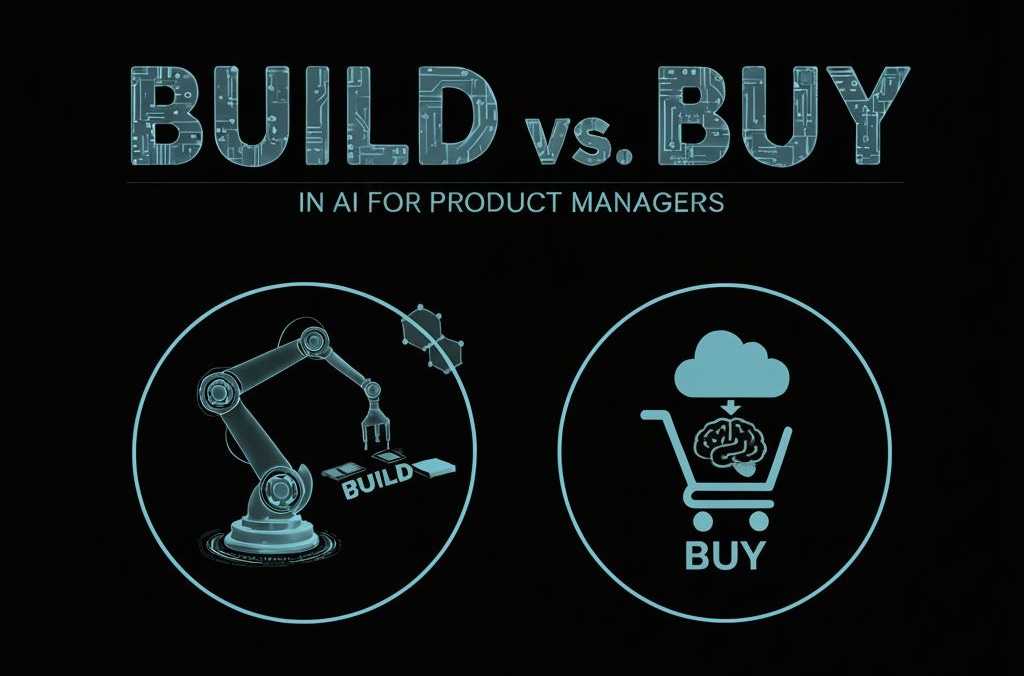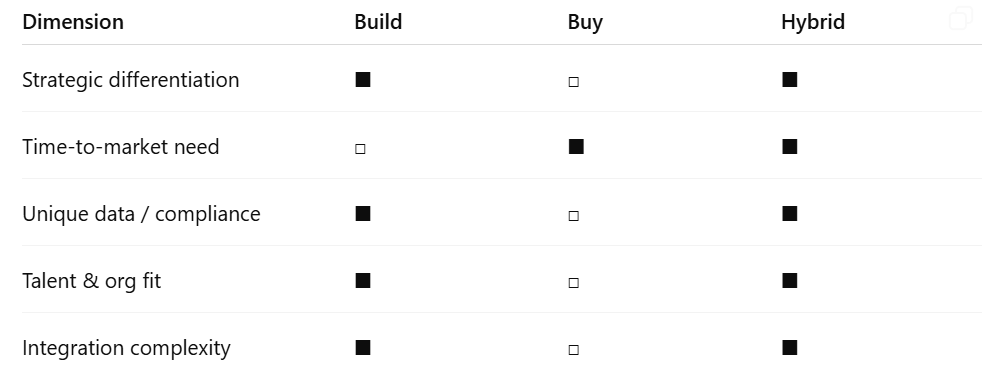Should You Build or Buy Your Next AI Capability?
A practical guide for Product Managers to cut through the noise and make the right call for their product.
TL;DR: Building AI in-house gives you control and long-term differentiation, but it’s expensive and slow. Buying accelerates deployment and taps mature tech, but creates integration and dependency risks. Most teams end up hybrid - build the core, buy the commodity, and orchestrate both.
What’s really at stake (for PMs)
This isn’t a binary decision. It’s a strategy fit problem - match your approach to your goals, culture, structure, and constraints.
Build fits companies chasing long-term differentiation and control. This usually means deep integration into your product architecture - custom models, data pipelines, and infra woven tightly into your systems. High investment, but high alignment.
Buy fits teams that need quick scalability and access to advanced capabilities. You move fast, but you still face integration work - connecting vendor APIs, aligning data flows, and ensuring the external tech fits your UX, reliability, and compliance needs.
Hybrid balances agility (buy) with innovation (build). You buy for immediate impact, while building the pieces where deep integration creates a moat.
Real-world playbooks
Build (moat first): Tesla
Built its own FSD chips, Dojo supercomputer, and custom vision stack. This is deep architectural integration - autonomy is inseparable from Tesla’s hardware and software. High R&D costs, but unmatched control.
Buy (speed first): Microsoft
Acquired Nuance and partnered with OpenAI to add best-in-class speech and generative AI. Buying gave them immediate capability, but the hard part was integration into Azure and Office without breaking user experience.
Hybrid (balance first): IBM & Adobe
Built Watson (IBM) and Sensei (Adobe), but also acquired complementary players like Red Hat and Figma. Hybrid success came from deliberately integrating in-house platforms with bought components
Pattern:
Build when AI defines the product.
Buy when AI enhances the product.
Hybrid when scaling across multiple workflows.
A PM-friendly framework: decide in minutes, not months
1) Decision guardrails (ask these four)
Is this capability core to how we win?
→ If Yes, lean to Build (or Hybrid if time-boxed).Do we have unique data/workflows that improve outcomes?
→ If Yes, lean Build/Hybrid to exploit proprietary advantage.Is the business need urgent (time-to-market trumps uniqueness)?
→ If Yes, lean Buy for immediate impact.Will integration/compliance demands be heavy?
→ If Heavy, favor Build/Hybrid for control over pipelines, governance, and SLAs.
2) The 7S lens (translate strategy to org reality)
The McKinsey 7S framework gives PMs a useful way to think about Build vs Buy decisions:
Strategy - Build = long-term differentiation; Buy = rapid scale; Hybrid = balance.
Structure - Build = centralized R&D and AI labs; Buy = decentralized business units integrating acquisitions; Hybrid = integrated cross-functional setup.
Systems - Build = proprietary frameworks, MLOps pipelines, and in-house infra; Buy = vendor APIs, acquired platforms stitched in; Hybrid = orchestrate both.
Style - Build thrives in innovation-first cultures that celebrate experimentation; Buy fits efficiency-driven, results-oriented cultures; Hybrid demands adaptability.
Staff - Build requires specialized in-house researchers/engineers; Buy leverages acquired teams and integration specialists; Hybrid mixes both.
Skills - Build = deep technical ML/AI expertise; Buy = strong vendor management and integration skills; Hybrid = systems thinking and cross-disciplinary capability.
Shared values - Build cultures prioritize independence and control (e.g., Tesla, Google). Buy cultures emphasize speed, partnerships, and market responsiveness (e.g., Microsoft). Hybrid cultures value flexibility, pragmatism, and a “best tool for the job” mindset (e.g., IBM, Adobe).
PM insight - If your org looks like a “Buy” culture but you push a “Build” strategy, expect friction. Align your AI plan to org realities.
3) The staged path most teams take
Pilot with Buy → Prove value → Internalize the core → Settle in Hybrid.
In practice, Hybrid becomes the steady-state for many enterprises:
Build the foundational or highly differentiating layers.
Buy the specialized or commodity pieces.
Integrate deliberately so you can swap or expand without breaking the system.
PM insight - Don’t frame Build vs Buy as a one-off decision. Treat it as a phased strategy you revisit as usage, cost, and compliance change.
Decision aid: build-buy scorecard
Here’s a simple scorecard you can adapt to guide Build vs Buy discussions with execs and engineering.
Using build-buy scorecard
Assign your own weights based on company context.
A startup may weight time-to-market highest; an enterprise in a regulated space may emphasize compliance and integration.
Tally your scores to make trade-offs explicit.
Quick hits & closing thought
Build = moat. Invest when AI is your differentiator, not just a feature.
Buy = speed. Use when time-to-market outweighs uniqueness.
Hybrid = reality. Most companies end up here — design for it.
Stage it. Pilot with Buy → Prove → Internalize → Hybrid.
Keep escape hatches. Abstraction layers make future switches cheaper.
There’s no single “right” play. The best PMs adapt - aligning strategy with their org’s reality, and evolving as needs change.





